Haozhu Wang
Collaborative LLM Numerical Reasoning with Local Data Protection
Apr 01, 2025Abstract:Numerical reasoning over documents, which demands both contextual understanding and logical inference, is challenging for low-capacity local models deployed on computation-constrained devices. Although such complex reasoning queries could be routed to powerful remote models like GPT-4, exposing local data raises significant data leakage concerns. Existing mitigation methods generate problem descriptions or examples for remote assistance. However, the inherent complexity of numerical reasoning hinders the local model from generating logically equivalent queries and accurately inferring answers with remote guidance. In this paper, we present a model collaboration framework with two key innovations: (1) a context-aware synthesis strategy that shifts the query domains while preserving logical consistency; and (2) a tool-based answer reconstruction approach that reuses the remote-generated problem-solving pattern with code snippets. Experimental results demonstrate that our method achieves better reasoning accuracy than solely using local models while providing stronger data protection than fully relying on remote models. Furthermore, our method improves accuracy by 16.2% - 43.6% while reducing data leakage by 2.3% - 44.6% compared to existing data protection approaches.
A Systematic Survey of Automatic Prompt Optimization Techniques
Feb 24, 2025Abstract:Since the advent of large language models (LLMs), prompt engineering has been a crucial step for eliciting desired responses for various Natural Language Processing (NLP) tasks. However, prompt engineering remains an impediment for end users due to rapid advances in models, tasks, and associated best practices. To mitigate this, Automatic Prompt Optimization (APO) techniques have recently emerged that use various automated techniques to help improve the performance of LLMs on various tasks. In this paper, we present a comprehensive survey summarizing the current progress and remaining challenges in this field. We provide a formal definition of APO, a 5-part unifying framework, and then proceed to rigorously categorize all relevant works based on their salient features therein. We hope to spur further research guided by our framework.
Hierarchical Prompt Decision Transformer: Improving Few-Shot Policy Generalization with Global and Adaptive
Dec 01, 2024



Abstract:Decision transformers recast reinforcement learning as a conditional sequence generation problem, offering a simple but effective alternative to traditional value or policy-based methods. A recent key development in this area is the integration of prompting in decision transformers to facilitate few-shot policy generalization. However, current methods mainly use static prompt segments to guide rollouts, limiting their ability to provide context-specific guidance. Addressing this, we introduce a hierarchical prompting approach enabled by retrieval augmentation. Our method learns two layers of soft tokens as guiding prompts: (1) global tokens encapsulating task-level information about trajectories, and (2) adaptive tokens that deliver focused, timestep-specific instructions. The adaptive tokens are dynamically retrieved from a curated set of demonstration segments, ensuring context-aware guidance. Experiments across seven benchmark tasks in the MuJoCo and MetaWorld environments demonstrate the proposed approach consistently outperforms all baseline methods, suggesting that hierarchical prompting for decision transformers is an effective strategy to enable few-shot policy generalization.
Latent Skill Discovery for Chain-of-Thought Reasoning
Dec 07, 2023Abstract:Recent advances in Large Language Models (LLMs) have led to an emergent ability of chain-of-thought (CoT) prompting, a prompt reasoning strategy that adds intermediate rationale steps between questions and answers to construct prompts. Conditioned on these prompts, LLMs can effectively learn in context to generate rationales that lead to more accurate answers than when answering the same question directly. To design LLM prompts, one important setting, called demonstration selection, considers selecting demonstrations from an example bank. Existing methods use various heuristics for this selection, but for CoT prompting, which involves unique rationales, it is essential to base the selection upon the intrinsic skills that CoT rationales need, for instance, the skills of addition or subtraction for math word problems. To address this requirement, we introduce a novel approach named Reasoning Skill Discovery (RSD) that use unsupervised learning to create a latent space representation of rationales, called a reasoning skill. Simultaneously, RSD learns a reasoning policy to determine the required reasoning skill for a given question. This can then guide the selection of examples that demonstrate the required reasoning skills. Our approach offers several desirable properties: it is (1) theoretically grounded, (2) sample-efficient, requiring no LLM inference or manual prompt design, and (3) LLM-agnostic. Empirically, RSD outperforms existing methods by up to 6% in terms of the answer accuracy across multiple reasoning tasks.
A Review of Reinforcement Learning for Natural Language Processing, and Applications in Healthcare
Oct 23, 2023Abstract:Reinforcement learning (RL) has emerged as a powerful approach for tackling complex medical decision-making problems such as treatment planning, personalized medicine, and optimizing the scheduling of surgeries and appointments. It has gained significant attention in the field of Natural Language Processing (NLP) due to its ability to learn optimal strategies for tasks such as dialogue systems, machine translation, and question-answering. This paper presents a review of the RL techniques in NLP, highlighting key advancements, challenges, and applications in healthcare. The review begins by visualizing a roadmap of machine learning and its applications in healthcare. And then it explores the integration of RL with NLP tasks. We examined dialogue systems where RL enables the learning of conversational strategies, RL-based machine translation models, question-answering systems, text summarization, and information extraction. Additionally, ethical considerations and biases in RL-NLP systems are addressed.
Graph Neural Prompting with Large Language Models
Sep 27, 2023Abstract:Large Language Models (LLMs) have shown remarkable generalization capability with exceptional performance in various language modeling tasks. However, they still exhibit inherent limitations in precisely capturing and returning grounded knowledge. While existing work has explored utilizing knowledge graphs to enhance language modeling via joint training and customized model architectures, applying this to LLMs is problematic owing to their large number of parameters and high computational cost. In addition, how to leverage the pre-trained LLMs and avoid training a customized model from scratch remains an open question. In this work, we propose Graph Neural Prompting (GNP), a novel plug-and-play method to assist pre-trained LLMs in learning beneficial knowledge from KGs. GNP encompasses various designs, including a standard graph neural network encoder, a cross-modality pooling module, a domain projector, and a self-supervised link prediction objective. Extensive experiments on multiple datasets demonstrate the superiority of GNP on both commonsense and biomedical reasoning tasks across different LLM sizes and settings.
OL-Transformer: A Fast and Universal Surrogate Simulator for Optical Multilayer Thin Film Structures
May 19, 2023Abstract:Deep learning-based methods have recently been established as fast and accurate surrogate simulators for optical multilayer thin film structures. However, existing methods only work for limited types of structures with different material arrangements, preventing their applications towards diverse and universal structures. Here, we propose the Opto-Layer (OL) Transformer to act as a universal surrogate simulator for enormous types of structures. Combined with the technique of structure serialization, our model can predict accurate reflection and transmission spectra for up to $10^{25}$ different multilayer structures, while still achieving a six-fold time speedup compared to physical solvers. Further investigation reveals that the general learning ability comes from the fact that our model first learns the physical embeddings and then uses the self-attention mechanism to capture the hidden relationship of light-matter interaction between each layer.
OptoGPT: A Foundation Model for Inverse Design in Optical Multilayer Thin Film Structures
Apr 20, 2023Abstract:Foundation models are large machine learning models that can tackle various downstream tasks once trained on diverse and large-scale data, leading research trends in natural language processing, computer vision, and reinforcement learning. However, no foundation model exists for optical multilayer thin film structure inverse design. Current inverse design algorithms either fail to explore the global design space or suffer from low computational efficiency. To bridge this gap, we propose the Opto Generative Pretrained Transformer (OptoGPT). OptoGPT is a decoder-only transformer that auto-regressively generates designs based on specific spectrum targets. Trained on a large dataset of 10 million designs, our model demonstrates remarkable capabilities: 1) autonomous global design exploration by determining the number of layers (up to 20) while selecting the material (up to 18 distinct types) and thickness at each layer, 2) efficient designs for structural color, absorbers, filters, distributed brag reflectors, and Fabry-Perot resonators within 0.1 seconds (comparable to simulation speeds), 3) the ability to output diverse designs, and 4) seamless integration of user-defined constraints. By overcoming design barriers regarding optical targets, material selections, and design constraints, OptoGPT can serve as a foundation model for optical multilayer thin film structure inverse design.
Automated Optical Multi-layer Design via Deep Reinforcement Learning
Jun 21, 2020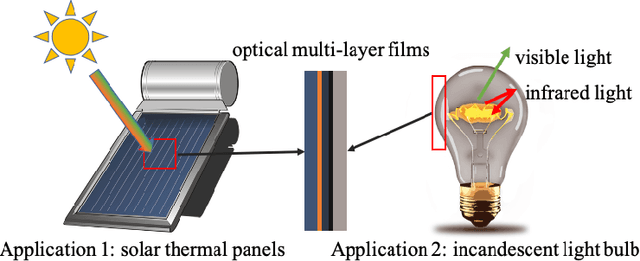

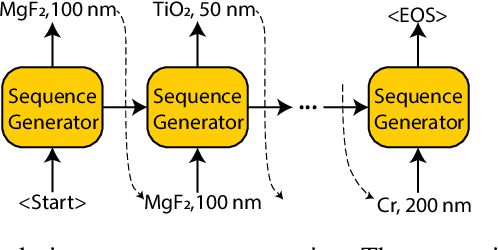
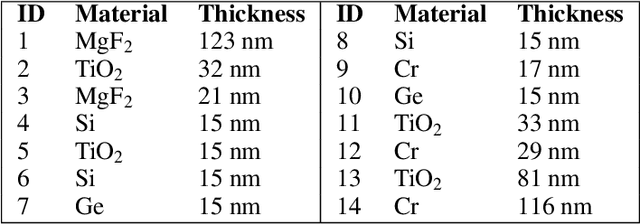
Abstract:Optical multi-layer thin films are widely used in optical and energy applications requiring photonic designs. Engineers often design such structures based on their physical intuition. However, solely relying on human experts can be time-consuming and may lead to sub-optimal designs, especially when the design space is large. In this work, we frame the multi-layer optical design task as a sequence generation problem. A deep sequence generation network is proposed for efficiently generating optical layer sequences. We train the deep sequence generation network with proximal policy optimization to generate multi-layer structures with desired properties. The proposed method is applied to two energy applications. Our algorithm successfully discovered high-performance designs, outperforming structures designed by human experts in task 1, and a state-of-the-art memetic algorithm in task 2.
Learning Credible Models
Jun 07, 2018

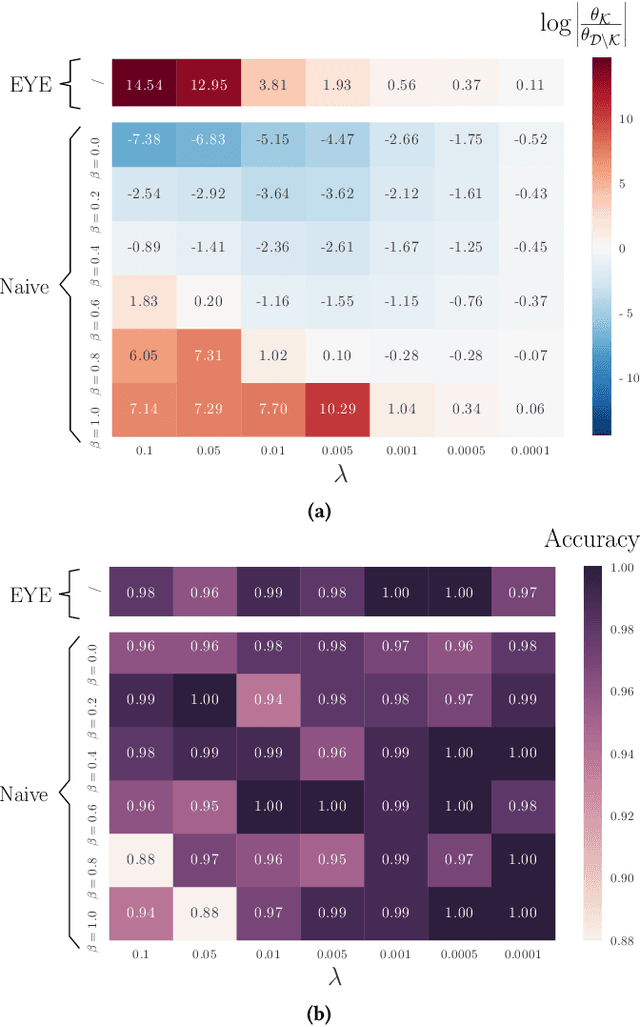
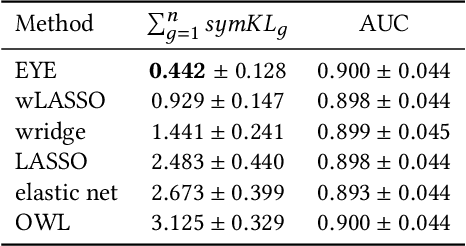
Abstract:In many settings, it is important that a model be capable of providing reasons for its predictions (i.e., the model must be interpretable). However, the model's reasoning may not conform with well-established knowledge. In such cases, while interpretable, the model lacks \textit{credibility}. In this work, we formally define credibility in the linear setting and focus on techniques for learning models that are both accurate and credible. In particular, we propose a regularization penalty, expert yielded estimates (EYE), that incorporates expert knowledge about well-known relationships among covariates and the outcome of interest. We give both theoretical and empirical results comparing our proposed method to several other regularization techniques. Across a range of settings, experiments on both synthetic and real data show that models learned using the EYE penalty are significantly more credible than those learned using other penalties. Applied to a large-scale patient risk stratification task, our proposed technique results in a model whose top features overlap significantly with known clinical risk factors, while still achieving good predictive performance.
 Add to Chrome
Add to Chrome Add to Firefox
Add to Firefox Add to Edge
Add to Edge